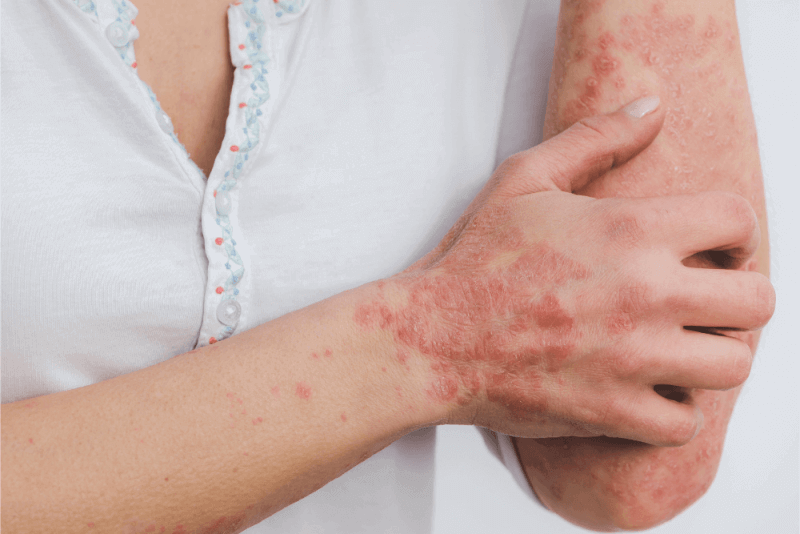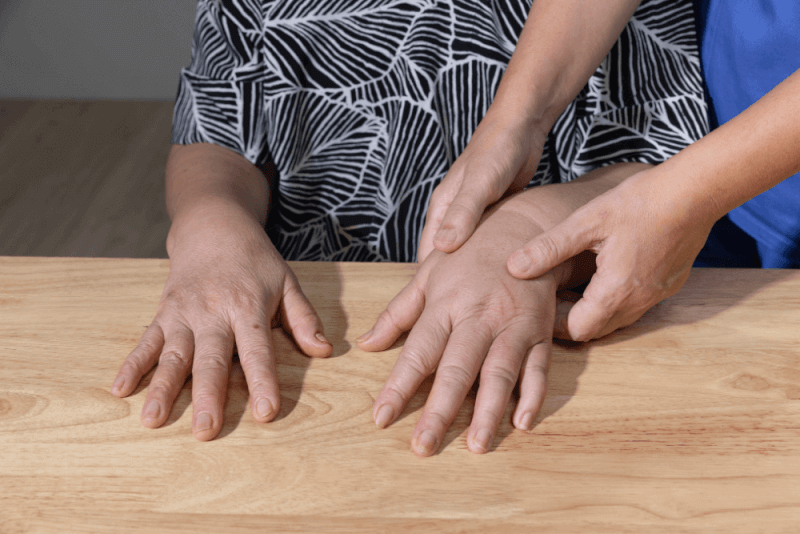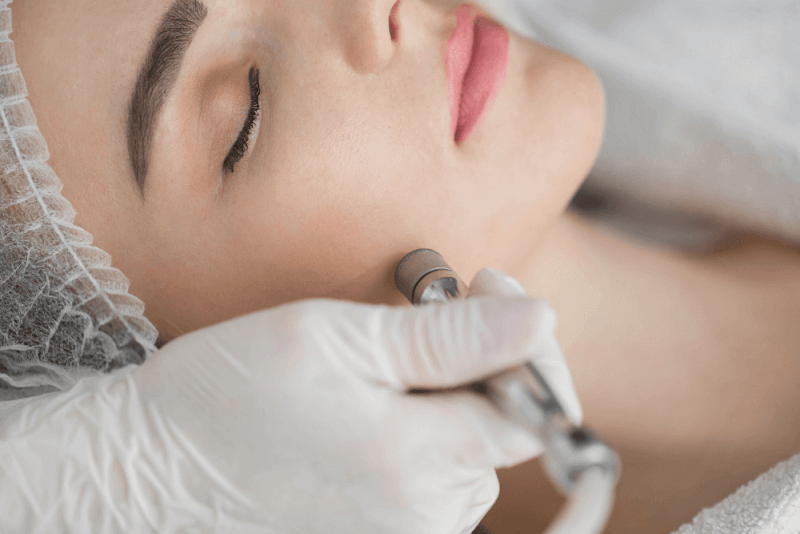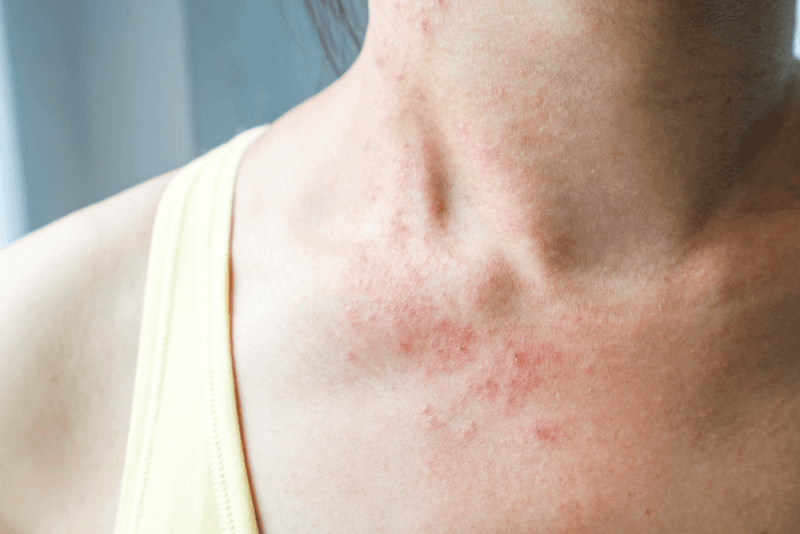What is Psoriasis?
Psoriasis is a type of skin disease caused by the skin cells multiplying ten times faster than normal. This results in bumpy patches on the skin. In fair-skinned individuals, these patches can be red or scaly. In darker-skinned individuals, the patches caused by psoriasis appear purple, violet, or gray and scaly.
Psoriasis can affect the entire skin surface but is usually found on the scalp, elbows, knees, and lower back. Although not contagious, psoriasis can sometimes be seen in other family members.
Psoriasis is a common and chronic disease with no cure. In some cases, it can be painful and affect sleep and concentration. Psoriasis occurs in cycles, flaring up for a few weeks or months and then subsiding for a while. Treatments for psoriasis aim to alleviate symptoms.
Diagnosis Methods for Psoriasis
Physical examination by dermatologists is usually sufficient for diagnosing psoriasis. During the examination, the following questions are asked:
- Is there a history of skin diseases in the family?
- When did the symptoms first appear?
- Have any home treatments been tried?
- Are these symptoms being seen for the first time?
- What types of skin cleansers are used?
Psoriasis is diagnosed based on the appearance of the skin plaque caused by the disease. However, since the symptoms of psoriasis can be related to other similar skin conditions, a skin biopsy can be performed to confirm the diagnosis. In a skin biopsy, specialists take a small skin tissue sample from the plaque and examine it under a microscope.
Causes of Psoriasis
The primary cause of psoriasis is an overreactive immune system that causes inflammation in the skin. In psoriasis patients, the immune system, which is normally programmed to keep the body healthy and prevent diseases, mistakes healthy cells for foreign invaders.
As a result, the immune system causes inflammation and swelling on the skin surface, which we see as skin plaques. Normally, the growth and replacement of skin cells occur within a 30-day period.
However, the overreactive immune system shortens the timeline for new skin cell development to 3-4 days. This rapid change accelerates the replacement of old cells with new ones, causing scaling and frequent skin shedding on the plaques.
Psoriasis is a genetically transmissible disease, so it can be seen in family members of a person with psoriasis. Factors that contribute to the flare-up periods of psoriasis include:
- Contact with an irritant or allergen trigger
- Emotional stress
- Infection
- Skin injuries like cuts, scrapes, or surgery
- Certain medications such as lithium and beta-blockers
- Changes in body temperature due to weather conditions
- Throat or skin infections
- Dry and cold weather
- Insect bites
- Severe sunburn
- Smoking or exposure to cigarette smoke
- Heavy alcohol consumption
- Rapid withdrawal of oral or injected corticosteroids
Symptoms of Psoriasis
The characteristic symptom of psoriasis is the formation of plaques on the skin surface. The appearance of these plaques includes:
- A raised area of thick skin or rash
- Change in skin color on the plaque
- Scaly or easily shedding skin on the plaque
Other symptoms caused by psoriasis include:
- Itchy skin
- Dry and cracked skin
- Skin pain
- Pitting, cracking, or breaking of the nails
- Joint pain
Scratching the plaques caused by psoriasis can break the skin and lead to infection. Infections in psoriasis are extremely dangerous and symptoms include severe pain, swelling, and fever. Patients experiencing these symptoms should seek medical attention as soon as possible.
Areas Affected by Psoriasis
Psoriasis can occur anywhere on the skin. However, the most common areas include:
- Elbows
- Knees
- Palms
- Feet
- Inside the mouth
- Face
- Nails
- Genitals
- Lower back
Treatment Methods for Psoriasis
The treatment of psoriasis focuses on alleviating symptoms. Commonly used methods include:
- Steroid creams
- Vitamin A or retinoid creams
- Moisturizers for dry skin
- Vitamin B3 creams
- Anthralin to slow down skin cell production
- Medicated lotions or shampoos
When symptoms affect a small area of the skin, creams are usually sufficient. However, if large areas of the skin are affected and patients experience joint pain, different treatments are applied.
Joint pain in patients can be a sign of arthritis. If these conditions develop, a more comprehensive treatment plan is necessary. Factors to consider when deciding on a treatment plan include:
- Severity of the redness
- Patient’s overall health
- Patient’s age
- Location of the redness on the body
Special Treatments for Psoriasis
If the treatments applied for psoriasis are ineffective or more than 10% of the skin is affected by the disease, the following treatments may be recommended:
Light Therapy
LED lights at specific wavelengths help reduce skin inflammation and slow down skin cell production. It is the first-line treatment for moderate to severe psoriasis, either alone or in combination with medications. Controlled amounts of natural or artificial light are applied to the skin. Treatments need to be repeated. Different types of therapy are available, including:
Sunlight
Also known as heliotherapy, this method involves short daily exposure to sunlight. Before starting with sunlight, it is necessary to determine the safest way to use natural light for psoriasis treatment with a healthcare professional.
Goeckerman Therapy
This approach combines coal tar treatment with light therapy. It can be more effective than using coal tar alone because coal tar makes the skin more sensitive to ultraviolet B light.
UVB Broad Band
Controlled doses of UVB broad-band light from an artificial light source are used to treat single psoriasis, widespread psoriasis, and psoriasis that does not improve with topical treatments. Short-term side effects include inflammation, skin itching, and dry skin.
UVB Narrow Band
This treatment can be more effective than broad-band therapy, which is why it has replaced broad-band therapy in many applications. It is usually applied two or three times a week until the skin improves and then less frequently for maintenance. However, narrow-band UVB phototherapy can cause more severe side effects than UVB broad-band.
Excimer Laser
In this treatment, a powerful UVB light is delivered only to the affected skin. Excimer laser therapy requires fewer sessions than traditional phototherapy because it uses stronger UVB light. Side effects may include inflammation and blistering.
PUVA
In this treatment, a special drug called psoralen is exposed to ultraviolet light.
Retinoids
These vitamin A-containing drugs can help reduce the symptoms of psoriasis. However, these drugs have many side effects, including birth defects.
Immunotherapy
These newer treatments block the body’s immune system with biologic drugs and small molecule inhibitors. This minimizes autoimmune reactions.
Methotrexate
This drug is recommended for patients with severe psoriasis. It can cause liver disease, so patients taking it must be monitored with blood tests and periodic liver biopsies to check liver health.
Cyclosporine
Another drug recommended for patients with severe psoriasis is cyclosporine, which can cause high blood pressure and kidney damage.
Calcineurin Inhibitors
These inhibitors, which help reduce rashes and scaly buildup, are especially beneficial for thin skin areas around the eyes where steroid creams or retinoids can be irritating or harmful.
Salicylic Acid
Salicylic acid is found in shampoos and scalp solutions and helps reduce the scaling of scalp psoriasis. It can be sold over-the-counter or by prescription and can be used alone or in combination with other topical treatments.
Coal Tar
Coal tar helps reduce itching and inflammation. Available in various forms, including shampoos, creams, and oils, these products can be sold over-the-counter or by prescription. They are not recommended for pregnant or breastfeeding women.
Alternative Medicine
Some studies on psoriasis suggest that alternative treatments not part of traditional medical care or developed outside traditional Western practices can alleviate psoriasis symptoms. Examples of alternative treatments used by people with psoriasis include vitamins, special diets, acupuncture, and some herbal products. While there is no strong evidence that these approaches work, they are generally safe and can help reduce itching and scaling in people with mild to moderate psoriasis. The most commonly used methods include:
Aloe Vera Cream
Using aloe vera cream from the leaves of the aloe vera plant can reduce itching and inflammation. To see any improvement, the cream needs to be applied several times a day for a month or more.
Fish Oil Supplements
Oral fish oil taken with UVB therapy can reduce the size of rashes. Applying fish oil to the affected skin and covering the area with a dressing for 6 hours a day for 4 weeks can help reduce scaling.
Oregon Grape
Applying Oregon grape to the skin can help reduce the severity of psoriasis.
Lifestyle and Home Remedies
To better manage psoriasis, personal care measures should be taken, including:
Daily Bathing
Instead of scrubbing the skin in the shower or bath, gently wash it with warm water and mild soaps added with oils. Adding bath oil, Epsom salts, or oatmeal to the bath water and soaking for at least 15 minutes can help manage symptoms.
Moisturizing
Moisturizers should be applied daily. After applying moisturizers after bathing, pat dry lightly. For very dry skin, oil or heavy ointment-based moisturizers can be preferred. These remain on the skin longer than creams or lotions. If you believe moisturizing helps your skin, you can apply the product more than once a day. Using a humidifier to add moisture to the air if the climate is very dry can also help manage symptoms.
Covering the Affected Area
Before bed, apply an ointment-based moisturizer to the affected skin and wrap it in plastic wrap to keep it moisturized more effectively overnight. Remove the wrap in the morning and wash off the scales.
Sunlight
Consult a specialist before using natural sunlight to treat psoriasis. Controlled amounts of sunlight can improve psoriasis. However, too much sunlight can trigger flare-ups and worsen the condition. Record the time spent in the sun and protect unaffected skin with sunscreen with at least SPF 30.
Protecting the Skin
Avoid scratching the affected areas of psoriasis. Applying anti-itch cream or ointment containing hydrocortisone or salicylic acid can help. If you have scalp psoriasis, try a medicated shampoo containing coal tar. Keep nails trimmed to prevent scratching the skin, and choose soft fabrics that do not contribute to itching.
Avoiding Triggers
Psoriasis triggers vary among patients, so it is important to pay attention to what triggers the disease and avoid those triggers.
Regulating Body Temperature
Hot weather can cause skin itching. On hot days, wearing light clothing and using air conditioning is recommended. Applying cold packs to itchy spots for a few minutes can also help reduce itching.
Healthy Lifestyle
Other healthy lifestyle habits that can help manage psoriasis include limiting alcohol consumption, staying active, eating well, and maintaining a healthy weight.
Complications of Psoriasis
People with psoriasis are at higher risk of developing other health conditions, including:
- Psoriatic arthritis, which causes pain, stiffness, and swelling in and around the joints
- Mental health issues such as low self-esteem and depression
- Temporary changes in skin color where plaques heal
- Celiac disease
- Multiple sclerosis
- Crohn’s disease
- Conjunctivitis
- Blepharitis
- Uveitis
- Cardiovascular diseases
- Obesity
- High blood pressure
- Type 2 diabetes
Types of Psoriasis
There are several different types of psoriasis, with the most common types including:
Plaque Psoriasis
The most common type of psoriasis, affecting approximately 80-90% of patients.
Guttate Psoriasis
Caused by a streptococcal infection, guttate psoriasis can appear after a sore throat. This type of psoriasis, characterized by small red and drop-shaped scaly spots, typically affects children and young adults.
Pustular Psoriasis
In pustular psoriasis, small pus-filled bumps appear on the plaques caused by psoriasis.
Nail Psoriasis
Individuals with nail psoriasis experience discoloration, pitting, and changes in their nails, particularly toenails.
Erythrodermic Psoriasis
A severe type of psoriasis that affects more than 90% of the skin, causing widespread skin discoloration and peeling. It is also the least common type of psoriasis.
Inverse Psoriasis
Inverse psoriasis primarily affects the folds of the groin, buttocks, and breasts, causing inflamed skin lesions that worsen with friction and sweating. Fungal infections can trigger this type of psoriasis.
Sebopsoriasis
This type typically appears on the face and scalp as oily yellow scaly bumps and plaques. It is a cross between psoriasis and seborrheic dermatitis.








